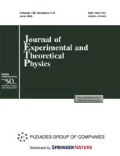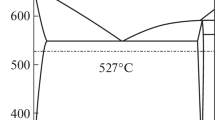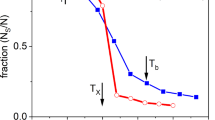Abstract
The glass transition of the supercooled Zr–Nb melt has been investigated by molecular dynamics simulation. The dependence of the critical glass transition rate on the percentage of Nb in the melt is obtained. It is found that the structure of amorphous Zr–Nb alloy is formed by interpenetrating icosahedral clusters. The dependences of the number of polyhedrons on the Nb percentage are obtained for main types of Voronoy polyhedrons. The increase in the number of icosahedrons corresponding to a larger number of neighbors is explained by the difference in the sizes of Zr and Nb atoms. It is shown that the splitting of the second peak of the radial distribution function and the increase in the number of icosahedral clusters in the amorphous structure occur simultaneously. The splitting of the second peak of the radial distribution function is explained by fixed distances between atoms in the system of interpenetrating clusters. Using several structural criteria, we have determined the glass-transition temperatures of a Zr–Nb melts with different percentages of Nb. The values of these temperatures are found to be in good agreement with one another.















Similar content being viewed by others
REFERENCES
I. V. Zolotukhin and Yu. E. Kalinin, Sov. Phys. Usp. 33, 720 (1990).
T. Egami and D. Srolovitz, J. Phys. F 12, 2141 (1982).
P. H. Gaskell, J. Non-Cryst. Sol. 75, 329 (1985).
Y. Waseda and H. S. Chen, Phys. Status Solidi A 49, 387 (1978).
E. M. Kirova, G. E. Norman, and V. V. Pisarev, JETP Lett. 110, 359 (2019).
X. J. Liu, Y. Xu, X. Hui, et al., Phys. Rev. Lett. 105, 155501 (2010).
L. N. Kolotova, G. E. Norman, and V. V. Pisarev, Russ. J. Phys. Chem. A 89, 802 (2015).
K. V. Reddy and S. Pal, Comput. Mater. Sci. 158, 324 (2019).
H. W. Sheng, W. K. Luo, F. M. Alamgir, et al., Nature (London, U.K.) 439, 419 (2006).
M. Hoare, Ann. N.Y. Acad. Sci. 279, 186 (1976).
Y. D. Wei, P. Peng, Z. Z. Yan, et al., Comput. Mater. Sci. 123, 214 (2016).
M. Wakeda, Y. Shibutani, S. Ogata, et al., Intermetallics 15, 139 (2007).
Z. C. Xie, T. H. Gao, X. T. Guo, et al., Phys. B (Amsterdam, Neth.) 440, 130 (2014).
Y. C. Liang, R. S. Liu, Y. F. Mo, et al., J. Alloys Compd. 597, 269 (2014).
S. P. Pan, J. Y. Qin, W. M. Wang, et al., Phys. Rev. B 84, 092201 (2011).
T. Fukunaga, K. Itoh, T. Otomo, et al., Intermetallics 14, 893 (2006).
A. V. Evteev, A. T. Kosilov, and E. V. Levchenko, JETP Lett. 76, 104 (2002).
I. S. Gordeev and S. V. Starikov, J. Exp. Theor. Phys. 128, 747 (2019).
A. V. Nikulina, Vopr. At. Nauki Tekh., No. 1, 190 (2005).
T. P. Chernyaeva and V. M. Gritsina, Vopr. At. Nauki Tekh., No. 2, 97 (2011).
I. I. Deryavko, D. I. Zelenskii, I. G. Perepelkin, et al., Vestn. NYaTs RK, No. 2, 105 (2015).
D. E. Smirnova and S. V. Starikov, Comput. Mater. Sci. 129, 259 (2017).
D. Y. Lin, S. S. Wang, D. L. Peng, et al., J. Phys.: Condens. Matter 25, 105404 (2013).
Y. Mishin, M. J. Mehl, and D. A. Papaconstantopoulos, Acta Mater. 53, 4029 (2005).
S. Plimpton, J. Comp. Phys. 117, 1 (1995).
N. N. Medvedev, Voronoi-Delaunay Method in Structural Studies of Noncrystalline Systems (Sib. Otdel. RAN, Novosibirsk, 2000) [in Russian].
D. S. Sanditov and M. I. Ojovan, Phys. Usp. 62, 111 (2019).
H. R. Wendt and F. F. Abraham, Phys. Rev. Lett. 41, 1244 (1978).
E. V. Levchenko, A. V. Evteev, S. Yu. Vakhmin, A. T. Kosilov, and A. Yu. Pryadil’shchikov, Phys. Met. Metallogr. 109, 563 (2010).
A. Yu. Pryadilshchikov, A. T. Kosilov, A. V. Evteev, and E. V. Levchenko, J. Exp. Theor. Phys. 105, 1184 (2007).
A. Stukowski, Modell. Simul. Mater. Sci. Eng. 18, 015012 (2009).
Yu. D. Tret’yakov, L. I. Martynenko, A. N. Grigor’ev, et al., Inorganic Chemistry. Chemistry of Elements, The School-Book for Higher School (Khimiya, Moscow, 2001), Vol. 1 [in Russian].
A. V. Bondarev, I. L. Bataronov, and I. M. Pashueva, Vestn. Voronezh. Tekh. Univ. 13, 122 (2017).
Y. Zhang, R. Ashcraft, M. I. Mendelev, et al., J. Chem. Phys. 145, 204505 (2016).
S. R. Wilson and M. I. Mendelev, Philos. Mag. 95, 224 (2015).
T. V. Tropin, G. Schulz, J. W. P. Schmelzer, et al., J. Non-Cryst. Sol. 409, 63 (2015).
N. Yu. Konstantinova, P. S. Popel’, and D. A. Yagodin, High Temp. 47, 336 (2009).
V. M. Kuz’menko, B. G. Lazarev, V. I. Mel’nikov, et al., Ukr. Fiz. Zh. 21, 883 (1976).
T. V. Tropin, J. W. P. Schmelzer, and C. Schick, J. Non-Cryst. Sol. 357, 1291 (2011).
D. P. B. Aji and G. P. Johari, J. Chem. Phys. 142, 214501 (2015).
ACKNOWLEDGMENTS
The authors are grateful to the Interdepartmental Supercomputer Center of the Russian Academy of Sciences for the possibility to perform calculations using the MVS-10P computer cluster.
Funding
This study was supported by program no. 6 of the Presidium of the Russian Academy of Sciences “New approaches to obtaining and investigation of extremal state of matter” (coordinated by Acad. V.E. Fortov).
Author information
Authors and Affiliations
Corresponding author
Additional information
Translated by N. Wadhwa
Rights and permissions
About this article
Cite this article
Kliavinek, S.S., Kolotova, L.N. Molecular Dynamics Simulation of Glass Transition of the Supercooled Zr–Nb Melt. J. Exp. Theor. Phys. 131, 284–297 (2020). https://doi.org/10.1134/S1063776120080105
Received:
Revised:
Accepted:
Published:
Issue Date:
DOI: https://doi.org/10.1134/S1063776120080105




